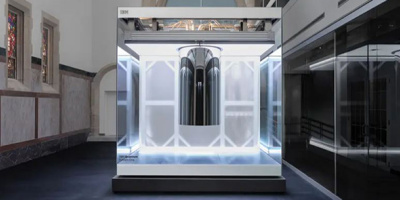CEO Arvind Krishna says IBM is taking a more realistic approach to artificial intelligence these days, and customers are more prepared to use the technology
International Business Machines Corp. researchers spent decades developing artificial intelligence when most of the world wasn’t ready to embrace it, and the company struggled at times to build a business around it. Now, as interest in AI booms amid new advances, IBM is tailoring the technology to address the individual business problems of customers that are prepared to use it.
“I think we’ve all talked a lot about AI as a fundamentally transformative technology and I think maybe over the last few months, now, the world is coming to agree,” IBM Chief Executive Arvind Krishna said during an interview at company headquarters. “I think before that they might not have disagreed, but I’m not sure they fully believed.”
IBM’s work in AI goes back to the 1950s. In 2011, the company’s Watson AI platform won a $1 million prize beating human rivals on “Jeopardy!” But Watson failed to to meet early expectations in the real world. Private-equity firm Francisco Partners acquired assets of IBM’s Watson Health business and created Merative, which emerged last year as a standalone company.But interest in AI is booming as never before following the release of OpenAI’s ChatGPT, which converses in natural language, and its Dall-E 2, which creates realistic-looking images. Microsoft Corp. has invested in OpenAI and is embedding the company’s technology across its own portfolio of products and services. Alphabet Inc.’s Google, Amazon.com Inc., Apple Inc., Meta Platforms Inc. and other big tech companies are all-in on AI, too.
The leap forward is the rise of so-called generative pretrained transformers. These networks, a form of deep learning, are trained on the internet as well as more tailored datasets to find long-range patterns in sequences of data, enabling AI software to come up with a fitting next word or paragraph as it writes.
IBM’s customers recognize the potential of the new technology, which can be used to summarize and analyze text, create software and much more, according to Mr. Krishna. The challenge for IBM and its customers is determining exactly how the majority of companies will utilize it.
Businesses see the utility of AI, but struggle with the need to spend money on experts to train and maintain original models, making it difficult to deploy AI at scale, according to Mr. Krishna.
Large tech companies, many operating in a mass consumer market, can rationalize investing $100 million or a $1 billion to train their own models. IBM will provide companies that aren’t willing or able to invest that much with models and help customize them for use by those clients, Mr. Krishna said.
While healthcare poses many problems that are theoretically addressable by AI, IBM’s Watson Health lacked the necessary brand, experience and domain knowledge to make it work, according to Mr. Krishna. The company also erred by offering the market an AI solution, while potential clients lacked the data infrastructure or people necessary to make AI work at scale, he said.
“I think the mistake we made in 2011 is that we concluded something correctly, but drew the wrong conclusions from the conclusions,” he said. This time, he said, IBM has a more realistic approach to AI.
Many corporations are better prepared for AI now, according to Kyle McNealy, a senior vice president of equity research at Jefferies who covers IBM. “Customers were not ready in 2011. Now, the landscape could be changing. More organizations have data infrastructure and engineers,” said Mr. McNealy, who has a buy rating on IBM.
IBM is now focusing its AI efforts on areas where it has experience and credibility with customers—automation, customer service and the application of AI to information-technology operations, according to Rob Thomas, IBM senior vice president for software and chief commercial officer. The company has built three foundational large language models that can be customized for customers, using their data as well as other sources, he said.
IBM said it began embedding foundation models, which can be reused for tasks they weren’t specifically trained on, into its products in 2019. It found them more accurate and cost-effective than previous models. That year it began using one to underpin its offerings in natural-language processing. It was based on the open-source BERT model but IBM said its model went through a data-cleaning process to remove hate, bias and other issues before being rebranded WatBERT. It is for use by IBM clients using the Watson NLP library. IBM said the WatBERT doesn’t need as much training as older models and can be repurposed for a range of language tasks.
IBM developed a new AI-driven spoken-commentary feature for the Masters golf tournament, which uses foundation models including the IBM Watson text-to-speech library. It has automated the process of adding golf narration to 20,000 video clips, according to IBM.
In 2022, IBM created two more foundation models. Project Wisdom automatically generates code for developers using IBM’s Red Hat Ansible tools. One goal was to achieve high levels of accuracy with a smaller computing footprint, according to IBM.
MoLFormer-XL, launched in January 2022, makes it faster and easier to screen molecules for new applications or create them from scratch, IBM said. Biopharmaceutical company Moderna and IBM are exploring the application of MoLFormer-XL to Moderna’s design and optimization process for mRNA medicines, according to IBM and Moderna.
IBM is also conducting a research partnership with the Cleveland Clinic called the Cleveland Clinic-IBM Discovery Accelerator. The group is using IBM’s open-source Generative Toolkit for Scientific Discovery, which includes models that can generate new molecule designs useful in materials and drug discovery. As the work continues to evolve, IBM’s MoLFormer-XL chemical language model could be used as well, according to Ahmet Erdemir, Cleveland Clinic’s chief scientist for the accelerator.
Says Mr. Krishna: “The maturity of data operations within enterprises was an impediment. You need to get to a certain maturity level before you can do more with AI and data.”
Write to Steven Rosenbush at






















 More than ever, there is a demand for IT to deliver innovation. Your IBM i has been an essential part of your business operations for years. However, your organization may struggle to maintain the current system and implement new projects. The thousands of customers we've worked with and surveyed state that expectations regarding the digital footprint and vision of the company are not aligned with the current IT environment.
More than ever, there is a demand for IT to deliver innovation. Your IBM i has been an essential part of your business operations for years. However, your organization may struggle to maintain the current system and implement new projects. The thousands of customers we've worked with and surveyed state that expectations regarding the digital footprint and vision of the company are not aligned with the current IT environment. TRY the one package that solves all your document design and printing challenges on all your platforms. Produce bar code labels, electronic forms, ad hoc reports, and RFID tags – without programming! MarkMagic is the only document design and print solution that combines report writing, WYSIWYG label and forms design, and conditional printing in one integrated product. Make sure your data survives when catastrophe hits. Request your trial now! Request Now.
TRY the one package that solves all your document design and printing challenges on all your platforms. Produce bar code labels, electronic forms, ad hoc reports, and RFID tags – without programming! MarkMagic is the only document design and print solution that combines report writing, WYSIWYG label and forms design, and conditional printing in one integrated product. Make sure your data survives when catastrophe hits. Request your trial now! Request Now. Forms of ransomware has been around for over 30 years, and with more and more organizations suffering attacks each year, it continues to endure. What has made ransomware such a durable threat and what is the best way to combat it? In order to prevent ransomware, organizations must first understand how it works.
Forms of ransomware has been around for over 30 years, and with more and more organizations suffering attacks each year, it continues to endure. What has made ransomware such a durable threat and what is the best way to combat it? In order to prevent ransomware, organizations must first understand how it works. Disaster protection is vital to every business. Yet, it often consists of patched together procedures that are prone to error. From automatic backups to data encryption to media management, Robot automates the routine (yet often complex) tasks of iSeries backup and recovery, saving you time and money and making the process safer and more reliable. Automate your backups with the Robot Backup and Recovery Solution. Key features include:
Disaster protection is vital to every business. Yet, it often consists of patched together procedures that are prone to error. From automatic backups to data encryption to media management, Robot automates the routine (yet often complex) tasks of iSeries backup and recovery, saving you time and money and making the process safer and more reliable. Automate your backups with the Robot Backup and Recovery Solution. Key features include: Business users want new applications now. Market and regulatory pressures require faster application updates and delivery into production. Your IBM i developers may be approaching retirement, and you see no sure way to fill their positions with experienced developers. In addition, you may be caught between maintaining your existing applications and the uncertainty of moving to something new.
Business users want new applications now. Market and regulatory pressures require faster application updates and delivery into production. Your IBM i developers may be approaching retirement, and you see no sure way to fill their positions with experienced developers. In addition, you may be caught between maintaining your existing applications and the uncertainty of moving to something new. IT managers hoping to find new IBM i talent are discovering that the pool of experienced RPG programmers and operators or administrators with intimate knowledge of the operating system and the applications that run on it is small. This begs the question: How will you manage the platform that supports such a big part of your business? This guide offers strategies and software suggestions to help you plan IT staffing and resources and smooth the transition after your AS/400 talent retires. Read on to learn:
IT managers hoping to find new IBM i talent are discovering that the pool of experienced RPG programmers and operators or administrators with intimate knowledge of the operating system and the applications that run on it is small. This begs the question: How will you manage the platform that supports such a big part of your business? This guide offers strategies and software suggestions to help you plan IT staffing and resources and smooth the transition after your AS/400 talent retires. Read on to learn:
LATEST COMMENTS
MC Press Online